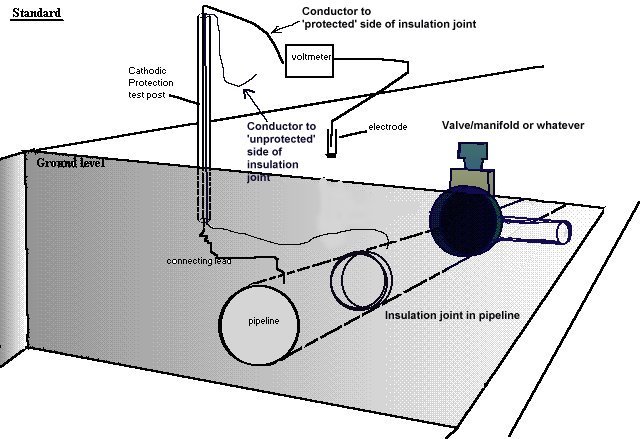

INSTRUMENTATION.
High resistance voltmeter.
Cu/CuSO4 electrode.
Two lengths of flexible cable, each fitted with a voltmeter connector and a crocodile clip.
Field notes
Report forms

1.1 Place the electrode firmly in the standard ground position.
1.2 Connect the electrode to the positive pole of the voltmeter.
1.3. Connect the negative pole of the voltmeter to the side of the isolation joint which is connected to the cathodic protection system.
Note. At a flowstation, this is normally the outgoing side.
1.4 Record the meter reading under the heading P.
The recorded voltage 'P' is the potential difference between the two poles of the meter, which is caused but the conductors leading to the pipeline metal and the electrode.
The potential of the pipeline metal is being manipulated by it's connection to the negative side of the cathodic protection transformer/rectifier or it's connection to a less noble metal in the form of a sacrificial anode.
It can also be effected by other electrical influences.
The 'P' stands for 'protected' but does not mean that the pipeline is cathodically protected, it means that the cathodic protection system is connected to this side of the isolation joint.
The expressions 'protected side' and 'the unprotected side' are in common use in some cathodic protection circles.1.5 Do not change the position of the electrode.
Connect the negative terminal of the meter to the side of the isolation joint which is not connected to the cathodic protection system.1.6 Record the meter reading under the heading UP. (Unprotected)
The position of the electrode is crucial to the value of both 'P' and 'UP' readings as it is the potential of the ground in which the electrode is placed which is on the positive side of the voltmeter. If the electrode is not moved it can be regarded as a reference to evaluate the potentials of the metal on each side of the isolation joint when they are connected to the negative side of the voltmeter.
However! The ground potential can fluctuate under certain external influences and this can effect the reading on the meter even though it might not effect the potential of the pipeline metal or the reaction potential of the steel/electrolyte interfaces. For this reason it is important to conduct the other procedures to confirm the credibility of the records obtained by this procedure.
NOTES
This is the standard type of measurement that has been recorded over many years by most operating organisations.
The reading will indicate that the CP is functioning and connected in the correct polarity.
It will indicate that the isolation joint is effective.
More information relating to isolation joints
Records of these readings will be useful when corrected by other procedures.